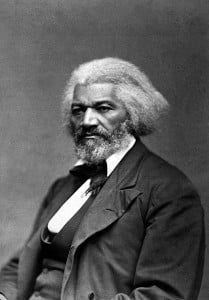~ by Amy Jenness, author of On This Day in Nantucket History, available at Mitchell’s Book Corner ~

“It was with the utmost difficulty that I could stand erect, or that I could command and articulate two words without hesitation and stammering,” he later wrote in his 1845 autobiography Narrative of the Life of Frederick Douglass, an American Slave, Written By Himself.
It was the first time Douglass had given a formal speech and his remarks so ignited famed abolitionist William Lloyd Garrison’s passion that he rose and addressed the audience.
“Have we been listening to a thing, a piece of property, or a man?” he yelled.
The gathering of 500 people shouted back “A man! A man!”
“Shall such a man be held a slave in a Christian land?” Garrison then asked. “Shall such a man ever be sent back to bondage from the free soil of old Massachusetts?’
The crowd stood up and shouted “No! No! No!”
After that meeting Garrison invited Douglass to join the Massachusetts Anti-Slavery Society and travel the country on a lecture circuit. Douglass spent the rest of his life speaking and writing in favor of ending slavery and, in time, his fame and influence would surpass his mentor Garrison.
Named Frederick Augustus Washington Baily when he was born to a slave woman in 1818, Douglass never knew the identity of his white father and only saw his mother three or four times before she died when he was seven. He endured a brutal life as a slave until he was eight years old and then was sent to serve a family in Baltimore. In that house, where his existence was a bit easier, Douglass learned to read and write. He also learned of people – abolitionists – committed to ending the practice of enslaving human beings.
It was in Baltimore that Douglass began to learn of the world and worked to educate himself and his fellow slaves. He read as much as he could and later Douglass credited The Columbian Orator with clarifying and defining his views on human rights. Douglass taught other slaves to read the New Testament at a weekly church service, a practice slave owners would ultimately banish.
As a teenager, Douglass was sent back to rural Maryland where he worked for a particularly cruel owner. It took a couple of attempts and two years but Douglass managed to escape slavery in 1838 and headed north, settling in New Bedford, which had a vibrant community of free black people, with his new bride and changed his last name to Douglass.
Douglass’s message was not always well received, but he developed into a powerful and articulate orator as well as a prolific writer. At the urging of Garrison, Douglass published his autobiography in 1845, which became an international best seller. Fearing he would be captured and returned to slavery, Douglass spent the next two years in England, Scotland, and Ireland. Lecturing against slavery in the British Isles, English admirers of Douglass collected enough money to buy his freedom and in 1847 he returned to America a free man.
Douglass settled in Rochester, N.Y. where he published a newspaper called The North Star and continued to speak against social injustice. He joined the nation’s first suffragettes at their Seneca Falls women’s rights conference in 1848 and spoke convincingly in favor of giving women the right to vote. Based on his remarks, two thirds of those gathered voted to include the controversial measure into the convention’s resolutions.
By the time of the Civil War, Douglass was the most famous black man in America and used his influence to confer with US Presidents. After the war Douglass received political appointments to leadership roles in the Dominican Republic and Haiti and in 1877 was placed on the Equal Rights Party ticket—without his consent—as a vice presidential candidate.
Douglass spoke on Nantucket throughout his life. He returned to participate in anti-slavery conventions at the Atheneum in 1842 and 1843. In 1850 Douglass spoke again at the Atheneum, this time in its new building, the original having burned down in the Great fire of 1846. Douglass and J.C. Hathaway spoke against the Fugitive Slave Law. Passed that same year by the US Congress, the required law enforcement agents all over the country to return runaway slaves to their owners and charged a substantial fine to citizens who aided escaped slaves.
Douglass’ final Nantucket visit occurred in 1885 where he reminisced in a speech about his life as an escaped slave and involvement with the abolitionist movement. In February of 1895 Douglass returned home from a meeting of the National Council of Women in Washington and died of a massive heart attack or stroke. He is buried in Mount Hope Cemetery in Rochester, New York.